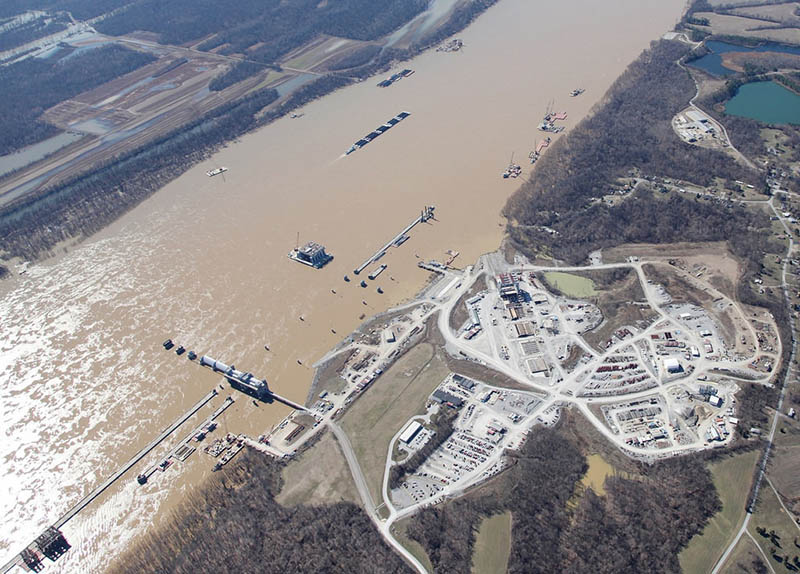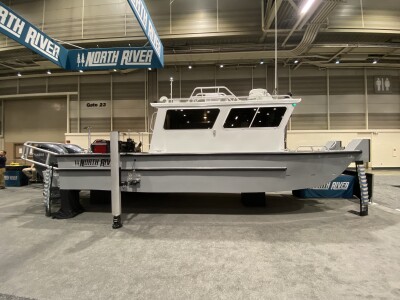After nearly three decades of construction delays and funding hiccups, the much-anticipated $3 billion Olmsted Lock and Dam project on the Ohio River is now estimated to open in the fall of 2018 or sooner, according to the U.S. Army Corps of Engineers.
Considered the nation’s most expensive and largest civil works project ever undertaken, the two new 1,200-foot locks and 2,500-foot dam across the river at Olmsted, Ill., will be fully functional next year. But the project won’t be completed until 2022 after the old locks 52 and 53 are removed from the river and cleanup work is finished on land.
The Corps says the new locks are complete, the dam is more than 80% done, and the remaining construction to prepare the project for an October 2018 opening will be finished by the end of this year.
The opening date could occur as much as four months earlier, however, depending on river conditions and approvals to speed up some construction steps.
“We are aggressively trying to advance that milestone to much closer to the start of the 2018 low water locking season, which historically occurs around the June timeframe,” Michael Braden, chief of the Olmsted Division in the Corps’ Louisville District, told WorkBoat.

Workers on the Olmsted Dam place tremie concrete inside the left boat abutment cofferdam in October 2016. In the background, Nav Pass Shell #9 is lowered onto the river bottom. USACE photo by Capt. Jeremy Nichols.
Braden said that a 2018 opening is four years earlier than a previous timetable, which put the opening in 2022 and completion in 2026. A continuous flow of funding from Washington, a re-evaluation of risks and costs of the project, and favorable river conditions that have allowed construction to extend beyond the traditional June to November low water season, have helped advance the project.
Braden said launching next year will save “tens of millions of dollars in overhead costs alone,” and assure more reliable and quicker movement of commerce along the river system sooner than later.
This is music to the ears of the barge industry. Operators have waited patiently for infrastructure improvements there for decades, suffering through long waits to lock through this important river thoroughfare, and agreeing to an increase more than a year ago in the federal taxes they pay on diesel fuel to finance lock and dam modernization.
“This is a big project for the industry,” said Martin Hettel, chairman of the Inland Waterways User Board, a federal advisory board, and vice president of government affairs at American Commercial Barge Line, one of the nation’s largest liquid and dry cargo barge companies. “About 90 million tons of products (from coal to grains) transit through this area annually.”
Because of the poor condition of the current locks, it can take up to 72 hours to raise the dam at lock 52, compared to 18 hours years ago, which causes long waits for barges, Hettel said.
Locking through can take up to five hours. When Olmsted is operational, locking time will be reduced to an hour or less.
“There will be a fourfold increase in efficiency as Olmsted provides for a single project with twin 1,200-foot locks rather than the status quo of two locks each with a single 1,200-foot lock. Reliability will also be significantly increased as the existing locks are decades beyond their designed service life,” the Corps’ Braden said.

Vessels transport equipment for the Olmsted Lock and Dam project in 2012. USACE photo by Mark Wise.
Located on the Ohio River at mile 964.6, about 17 miles upstream from where the Ohio joins the Mississippi, Olmsted sits on one of the busiest stretches of the inland waterways system for commercial navigation. The current locks and dam 52 and 53 date to the 1920s, and their antiquated operating system and age cause numerous shutdowns and delays for barge movements. The Olmsted replacement is being built a few miles from the old locks.
Plans to build Olmsted began in 1995, but have been slowed by inefficient federal funding, river conditions, construction cost increases and a decision to try an innovative “in the wet” construction technique that involved building sections of the dam on land and then placing them in the river. Traditionally the Corps builds cofferdams to hold back water and allow workers to assemble dams on the dry river bottom. The new method was favored, Braden said, because it reduces shipping delays since the river remains open during construction, and is less disruptive to the river’s ecosystem.
Speeding up the project is also the result of the “high level management the project has received in recent years,” said John S. Doyle Jr., a former Corps official and now a Washington, D.C., attorney working with the Waterways Council Inc., an industry-supported advocacy group for waterways funding.
“This is now a good news, not a bad news story,” Doyle said. “The Corps is on track to deliver it at $300 million below the re-estimated cost provided four-to-five years ago, and deliver it well-ahead of the previous start date set four-to-five years ago. The Corps turned the project around.”
A spate of negative publicity a few years ago that called Olmsted a boondoggle for ballooning costs and massive delays set into motion a stronger commitment from Congress to support the project, and a change in the funding formula under which Olmsted receives federal money. In addition, the project has become a priority for top brass at the Corps and two presidents who have vowed to get it finished.
President Trump alluded to Olmsted in a speech about infrastructure modernization in Cincinnati last week. He also included funding for Olmsted in his fiscal 2018 budget plan, and placed it on a priority list for his yet-to-be announced national infrastructure plan.
The Corps says when Olmsted opens, it will deliver nearly $640 million in net annual economic benefits to the country by replacing Locks 52 and 53 and no longer having to pay for their maintenance.





